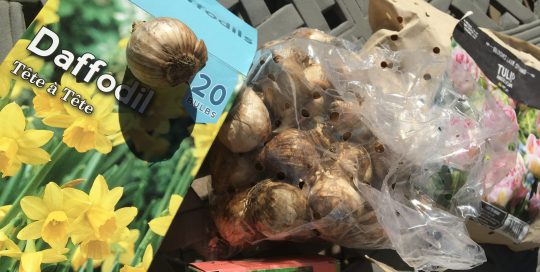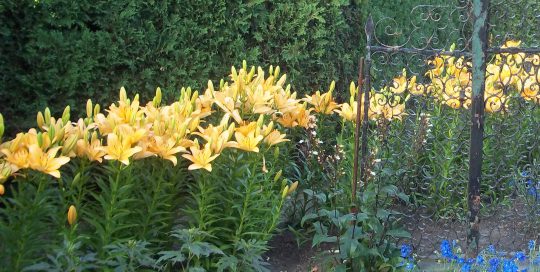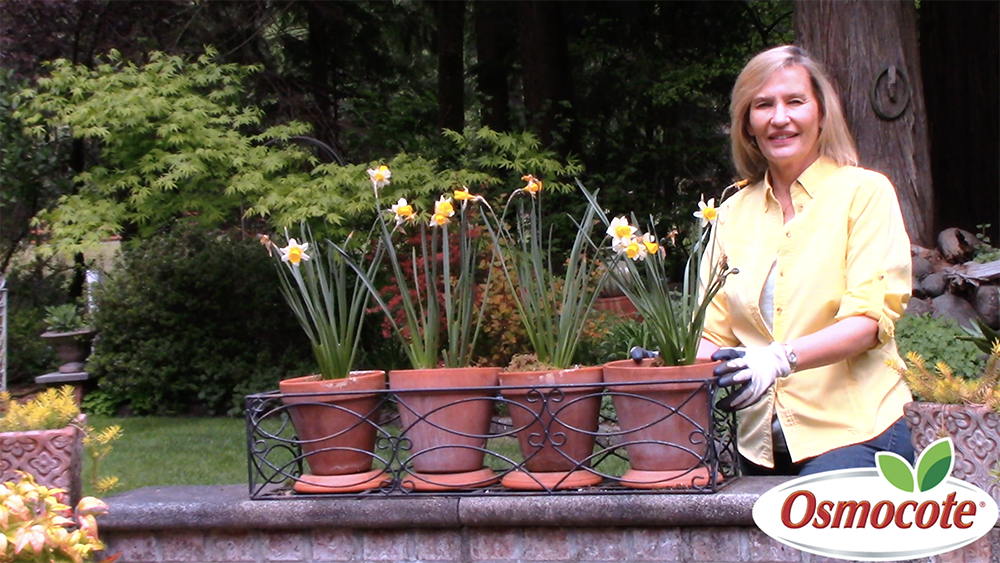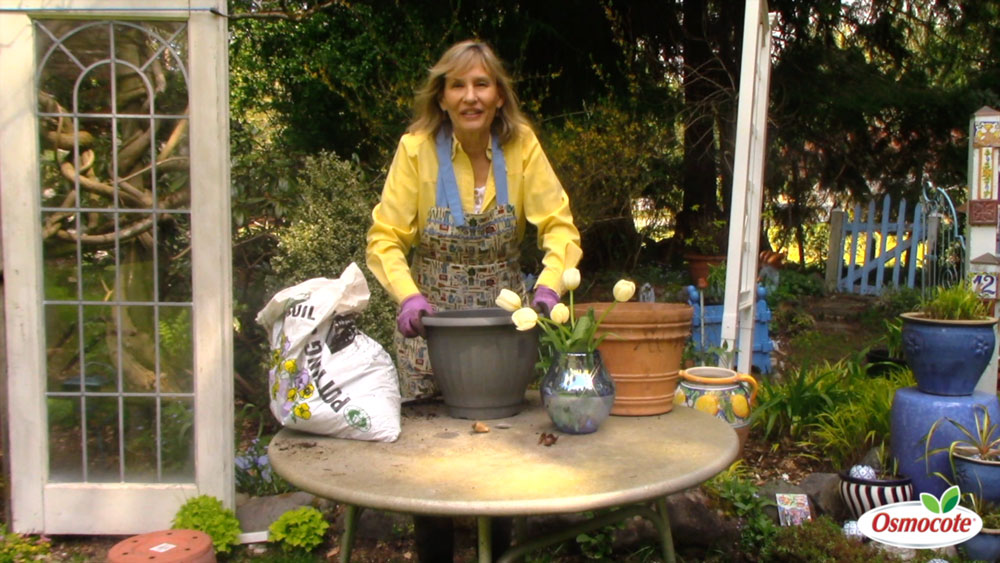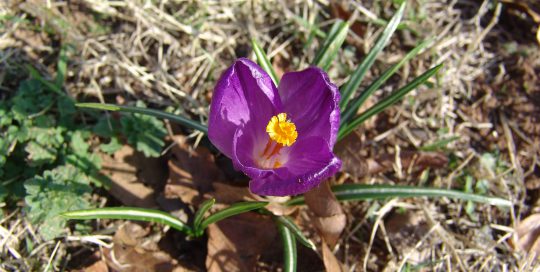Did you think bulbs were just for fall-planting? Tuck a few tender bulbs—those that won’t survive a cold winter outdoors—into a pot this spring for some exotic color and fragrance. Sometimes referred to as summer bulbs, and known mostly by their common names, I’ll offer a glimpse at Peruvian daffodils, rain lilies, Gladiolus and Mexican shell flower. Don’t forget to fertilize!
These four plants grow from chunky, variably-sized underground storage units similar to the tulip bulbs we’re most familiar with. But tulips, and the plants described here, fall into a larger category called geophytes—a catchall term for plants that grow from bulbs, rhizomes, corms, and tubers. These packets of nutrients and genetic material range in size from softball to marble. Some look like gnarly cigars, while others resemble dried out sweet potatoes. They’re not as recognizable as tulips and daffodils, so you’ll have to be on the lookout when visiting your local nursery. For even more variety, order them from online bulb specialists.
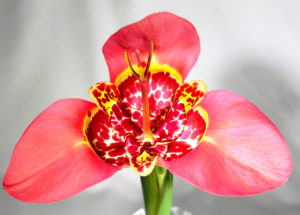
Peruvian Daffodils (Hymenocallis)
One of the easiest summer bulbs is Peruvian daffodil, or Hymenocallis. Another fairly common name for this exotic flower is “spider lily,” but that is also the common name for at least three other plants grown from bulbs. I’ve grown Hymenocallis in containers, tucked in with a variety of summer annuals. It gets along well in a large container with mid-sized coleus, or a well-behaved, late-to-the-party elephant ear. After planting, the bulbs sprout and bloom quickly, their thick and strappy leaves shooting straight up before their fat flower stems shove their way through. Set aside some time each day to sit and watch, because spider lily’s performance is your very own time-lapse floorshow, complete with a light evening fragrance.
No special soil is required for Hymenocallis, although I like to add some drainage in the form of vermiculite in order to keep it moist but not wet. After bloom is complete, let the leaves continue to grow in order to provide the bulb nutrients for next year. If the leaves get in the way, cut them back after at least a month. Northern gardeners (Zones 3-7) will have to make the decision to either leave the bulbs to die outdoors or bring them in and store them in a warmish garage or basement that stays above freezing.
Various species of Hymenocallis are native to the southeastern United States, through Mexico, Central America and northern South America.
Fairy Lilies
Fairy Lilies (Zephyranthes), also referred to as rain flowers because they often come into bloom after a rain, offer a big show for very little care. They are adorable in Azalea pots—or any pot that is wider than it is tall. The two-inch wide flowers grow from tiny bulbs that like to be planted close together, preferably in a clay pot.
They might bloom sparsely in their first year, but take them inside, pot and all, to winter in a room that stays above freezing (around 40-55 degrees F). They should be stored in dry soil, and when the weather warms up (usually late April to mid-May) I take them outside, give them a bit of water, and they never fail to surprise me with their eagerness to bloom.
I’ve grown both yellow (Z. primulina) and pink-flowered (Z. robusta) rain lilies, both of which flowered in early May, late June and again in late July. One year in August, I found a dried out pot of rain lilies in the back of the garage. I took them outside, gave them a good watering, and in a few days, they bloomed. This spring, I’ll be dividing and sharing these tiny South African bulbs, giving them fresh soil and a new sprinkling of Osmocote.
Although the species are fairly easy to find, Plant Delights Nursery carries nearly a dozen rare hybrid rain flowers.
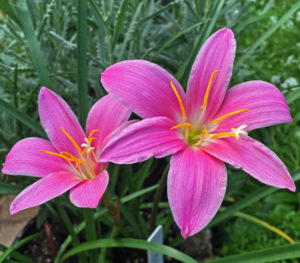
Gladiolus
I used to think these overly-statuesque spikes in curious color combinations had no place in a home garden. Now, I think differently after learning about the shorter, more garden-suited Gladiolus (glads), some of which have come back each year in my Zone 6a garden. I found my first batch of new old-fashioned varieties in the Old House Gardens catalog. I have three favorites so far, including ‘Starface’. It’s a patterned (multi-colored) variety introduced in 1960. I combine it in a large container with medium-height Coleus that contained colors similar to ‘Starface’: peach, yellow and red.
‘Atom’ made its first debut in 1946, and is still one of the closest to a true red flower as you’ll find. True red tends to go with everything in your garden, even the hard to match peach and orange. To make the color stand out even more, ‘Atom’s’ petals each wear a pencil-thin white stripe along their edges. I like to plant ‘Atom’ with poppies and dill, both of which serve to soften the upright stature of the glad.
I also have fallen in love with a variety called ‘Lucky Star’, a hybrid that can be hard to find. It is related to a species referred to as the Abyssinian glad (botanically G. callianthus or Acidanthera), which can be found at Brent and Becky’s Bulbs. Its fragrant white flowers appear in late summer, and if planted in a protected area, it could come back each year.
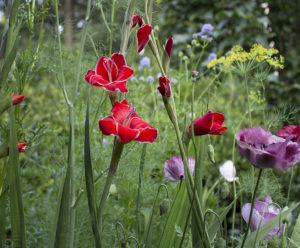
Mexican Shell Flower
Mexican shell flower (Tigridia) comes in shades of red, pink and yellow, but it’s their center that gives them their name. The recessed hub of each three-petaled flower resembles the spots on a jaguar. In its native range, the term, El tigre refers to the only big cat in North, Central and South America—the jaguar (Panthera onca). Tigridia also goes by other names, like peacock flower, but it’s one of the most unforgettable flowers you’re likely to see.
My sister saw them in bloom at my house one summer and said she thought they were the most beautiful flowers she’d ever seen. With its silky petals surrounding such an intricate center, the flower is certainly captivating. I like to plant Tigridia bulbs along with Gladiolus, as they take longer to bloom. When the glads are finished, the Tigridia flowers aren’t far behind. I’ve found they don’t mind a location in partial sun, but prefer very warm temperatures.
Of course, these tropical bulbs won’t survive a really cold winter. To save them for the following year, they’ll need to overwinter indoors. Some of these bulbs, like fairy lily and Gladiolus, are very inexpensive, so it’s no big deal if you miss the deadline for digging them up in the fall. Planting them in a pot of their own makes it simple to bring the, pot and all, inside for the winter. These four exotic plants certainly are just a taste of what’s available. Others I’ve grown include Gloriosa, pineapple lily, Crinum, African blood lily, ginger, and tuberose.
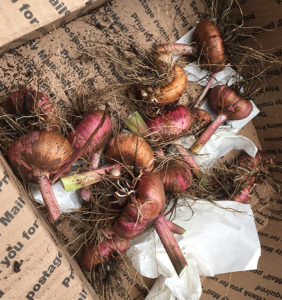
MAIL-ORDER BULB SOURCES
As with many types of plants, it’s best to go to the specialists to find the best selection of bulbs. Other sources include local plant societies.
- Brent and Becky’s Bulbs: Gloucester, VA 23061, Phone: 877-661-2852
- Easy to Grow Bulbs, Oceanside, CA
- Edens Blooms: Thatcher, AZ 85552, help@edensblooms.com
- Glasshouse Works: Stewart, OH 45778-0097, Phone: 740-662-2142,
- Longfield Gardens: Lakewood, NJ 08701, Phone: 855-534-2733
- Old House Gardens: Ann Arbor, MI 48103-4957, (734) 995-1486
- Plant Delights Nursery: Raleigh, NC
- Telos Rare Bulbs: Ferndale, CA 95536

